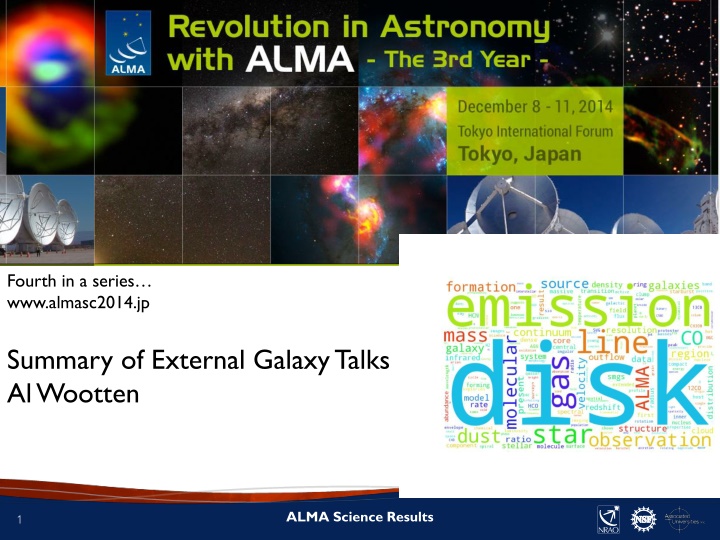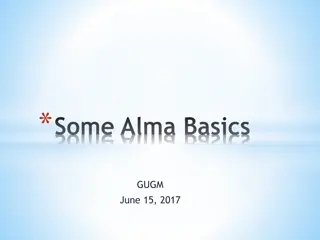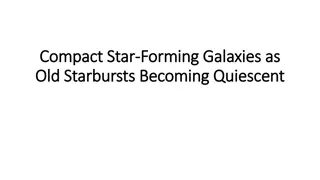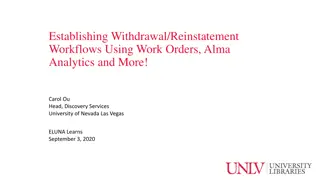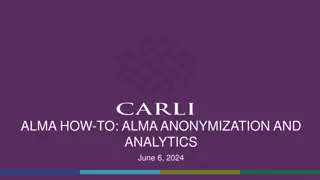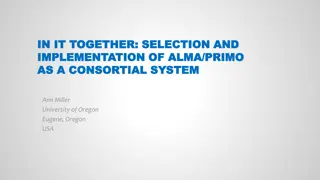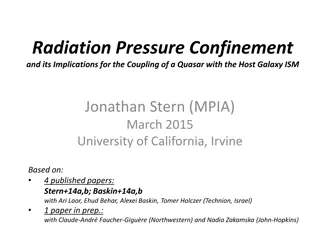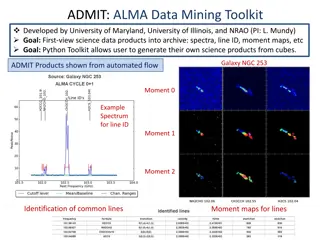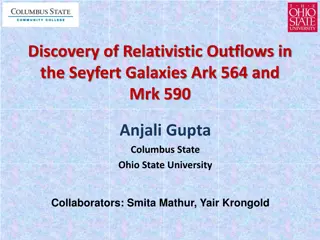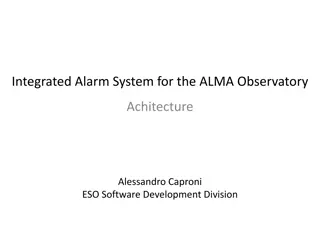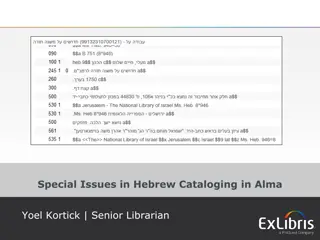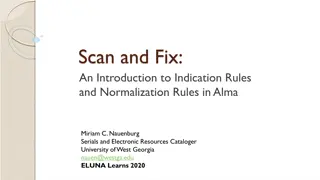ALMA Science Results in External Galaxies
ALMA is enabling studies of nuclear regions in galaxies, with challenges in distinguishing inflow from outflow. Prospects for dynamically measuring BH masses are excellent. ALMA's spectral grasp allows parallel analyses among a variety of species. Key components in galaxies are quantified using ALMA, including molecular clouds, dust, outflows, and supermassive black holes. Feedback mechanisms in galaxies are explored through spatially resolved imaging. The ALMA view offers insights into starburst phenomena and AGN feedback. Radio jets impacting feedback in Seyfert galaxies, driving molecular outflows in AGN, and more are observed using ALMA.
Download Presentation

Please find below an Image/Link to download the presentation.
The content on the website is provided AS IS for your information and personal use only. It may not be sold, licensed, or shared on other websites without obtaining consent from the author.If you encounter any issues during the download, it is possible that the publisher has removed the file from their server.
You are allowed to download the files provided on this website for personal or commercial use, subject to the condition that they are used lawfully. All files are the property of their respective owners.
The content on the website is provided AS IS for your information and personal use only. It may not be sold, licensed, or shared on other websites without obtaining consent from the author.
E N D
Presentation Transcript
Fourth in a series www.almasc2014.jp Summary of External Galaxy Talks Al Wootten ALMA Science Results 1
Themes ALMA s sensitivity and directivity enable studies of nuclear regions of galaxies Still difficult to disentangle inflow from outflow; in some cases motions were kinematically complex One needs a better measure of mass for most objects only a limit could be established Excellent prospects for measuring BH masses dynamically ALMA s broad spectral grasp enables parallel excitation analyses among up to ~40 species. ALMA Science Results 3
Revolution in Astronomy Galaxies and Galactic Nuclei I 9:45 - 10:15 (invited) Quantifying key components in galaxies using ALMA: molecular clouds, dust, outflows, and supermassive black holes Kotaro Kohno, University of Tokyo Star formation converts HI through molecules to stars; ALMA studies the intermediate step. Feedback: spatially resolved sensitive imaging critical for understanding feedback; ALMA provides this. Combined ALMA data with Nobeyama 45m for M83 image. NGC1808 Arp 220: 434 micron imaging with ALMA reveals fine structure of its two nuclei. West nucleus requires AGN owing to high luminosity surface density. NGC5044 group. ALMA Science Results 4
Kohno (cont) Outflows and Inflows in galaxies central kinematics. N1433-Combes et al.. CO deviates from ordered rotation: an outflow. NGC1566 shows no outflow. Many talks on feedback and outflow at this meeting. Measuring supermassive black holes with ALMA. Kinematic signature within rotation curve. Submm water maser lines offer promise for measuring central kinematics of galaxies (Hagiwara) 10:15 - 10:30 The ALMA view of the starburst in NGC 253 Alberto Bolatto, University of Maryland Nuclear starbursts thought to be especially important at z~1-2 in galaxies. What drives them? What quenches them? Nearby NGC253 offers a nearby example. Hot xray radn seen by Chandra. ALMA view? CO at high velocities correlates with the Xray streamers. Narrow, very turbulent short lifetime molecular structures. Streamer bases lie near expanding molecular shells which may initiate them. Outflow likely greater than 9 Msun/yr--may be lost but may be recycled. ALMA Science Results 5
10:50 - 11:05 Radio jets clearing the way: watching feedback in action in the Seyfert galaxy IC 5063 Raffaella Morganti, ASTRON, Kapteyn Institute H2 imaged with VLT, broad component near the jet. ALMA: 100pc resolution in CO 2-1 wraps around radio continuum well. Kinematics: Clear correspondence to disturbances along the jet, deviates from rotation curve. Model: jet expands in clumpy medium 11:05 - 11:20 How do you drive molecular outflows? ALMA s view of AGN feedback in NGC 1266 Timothy Davis, University of Hertfordshire Form: heats hot gas in galactic halos to prevent cooling. OR direct: removes star forming ISM Is it photon driven or jet driven? N1266 is most gas-rich early type galaxy in local Universe. Alatalo: CO shows outflow 500 km/s. Losing gas >110 Msun/yr. Chemistry can distinguish the form of the driver.SiO strong: shocks? Weak ionized lines. Outflow seems to be powered by a nascent AGN jet. ALMA Science Results 6
11:20 - 11:35 Ballistic molecular rain powers cold black hole feedback in a cool core brightest cluster galaxy Grant Tremblay, Yale University Thanks for making ALMA accessible to optical/Xray observers. A2597: 10 Msun/yr. z=.08. Cool core brightest cluster galaxy. Molecular gas follows ionized gas. CO2-1 with ALMA shows 2E9Msun cool gas. See a molecular fountain--molecular bubbles inflated by jet, permeated by young stars. Material slowly returns along filaments. Infalling gas seen which can power the fountain. 11:35 - 11:50 The molecular gas outflow of NGC 1068 imaged by ALMA Santiago Garcia-Burillo, OAN-IGN Outflow in ionized gas, also in molecular circumnuclear disk. Dense tracers imaged to r~2kpc at 20-35pc resolution. Find an off centered 200pc ring around AGN/ Kinematics--rotation and streaming. Find a molecular outflow at the circumnuclear disk. Half of mass in CND is involved in outflow driven by AGN feedback. star formation cannot drive this outflow. Many species also imaged. Radiation pressure on dust could drive the outflow. ALMA Science Results 7
11:50 - 12:05 ALMA observations of a candidate molecular outflow in obscured quasar SDSS J1356+1026 Ai-Lei Sun, Princeton University Redshift z=.123. N nucleus a galaxy, S nucleus less. Radio- quiet. ALMA provided resolutions to 0.77kpc. No CO at ionized outflow; gas is in N nucleus with 1kpc tidal arm, very broad line. Velocity too high to be rotation--outflow? Star formation rate <21 Msun/yr. S galaxy passes by N galaxy every 10^7 yrs. Perhaps at perigalaxion the extended ionized flow is stoked. ALMA Science Results 8
Galaxies and Galactic Nuclei II (chair: Alberto Bolatto) 13:30 - 14:00 (invited) Galaxies and galaxy nuclei with ALMA Susanne Aalto, Chalmers University of Technology Vibrationally excited molecules probe central regions but HCN and HCO+ are very optically thick owing to steep T gradient and large column Even may see self absorption in vibrationally excited lines. If starburst, a very hot one. Results consistent with a supermassive Black Hole accreting near Eddington limit. NGC1377: extreme FIR excess, radio-quiet with strong molecular outflow which could clear it in a few megayears. Driving source unknown--very young starburst or black hole? ALMA Cycle 2: flow flips in sense near nucleus. Origin unclear? Perhaps a jet in the plane of the sky precessing? NGC3256 offers a similar example. At the other end of the scale Mkn 231. Many molecules flowing at high velocity. ALMA reveals stunning richness in AGN and starburst nuclei in many lines. Extremely dust obscured nuclei show self absorbed emission from HCN, HCO+ and ALMA can detect the vibrational lines from them to probe near the central engine. ALMA Science Results 9
14:00 - 14:15 An ALMA spectral scan of the obscured luminous infrared galaxy NGC 4418 Francesco Costagliola, Chalmers University of Technology Obscured LIRGS. T>100K, l<100pc, SFR>10Msun/yr, N(H2)>10^24 cm^-2 so only radio and submm radiation can escape. How much radiation comes from star formation how much from active nuclei? Observe many spectral lines and compare them to probe excitation. Species often optically thick. Multiband scans provide many lines. 175GHz scan of NGC4418. Similar beam from 85-360GHz, The galaxy has high silicate absorption at ten microns. Narrow molecular lines, radio quiet. Lines provide 30% of flux Reach line confusion limit quickly; fit whole spectrum at once. Lots of HC3N, also vib-excited variant. Also HC5N. 40 molecules Vibrationally excited HCN, HNC, HC3N probe the 5pc size source at center. Temperatures vary >100K. A new chemistry? Can fit 90% of emission from lines. ALMA Science Results 10
Distributions of molecules in the circumnuclear disk and surrounding starburst ring in the Seyfert galaxy NGC 1068 observed with ALMA Shuro Takano: NRO45m 3mm survey laid foundation for ALMA survey. N1068: Syf 2 nucleus. 14.4Mpc distance so 1 =72pc. Circumnuclear disk has two knots. Selected spectral windows based on 45m data. In some lines, the ring dominates, in others the CND is also promonent. Astonishment no 1: Methanol differs in the ring from 13CO. Astonishment 2: Some complex species concentrate in CND where X-rays are strong: HNCO, CH3CN. Astonishment 3: Ten line distributions obtained with an hour time in Cycle 0 15:00 - 15:15 Diffuse and dense gas in nearby luminous merging galaxies Toshiki Saito, University of Tokyo Observed VV114, N3110, N1614 with ALMA. Some ALMA Cycle 2 results shown. CO 6-5 is more compact than low J CO. The CO 6-5 traces intense nuclear star formation. Claims that shocked regions traced in CS and CH3OH lines. ALMA Science Results 11
14:45 - 15:00 ALMA explorations of warm dense molecular gas in nearby LIRGs Kevin Xu, California Institute of Technology/IPAC .4mm CO 6-5, continuum How does warm gas distribute in LIRG nuclei Correlate with star formation? Are outflows important? When do AGNs dominate heating of gas and dust? NGC34 and NGC1614. Former has CO in unresolved core, warmer gas. AGN<19%. In N1614 no nuclear emission is seen. http://arxiv.org/abs/1410.6982 NGC34: rotating disk kinematics. Also emission from H13CN 8-7 in wing. For the latter, need mechanical heating in models. Or: it is not H13CN but a 400 km/s CO outflow. NGC1614. No compton-thick AGN. ALMA Science Results 12
16:15 - 16:35 (17+3) The molecular environment star formation and cluster dissolution across dynamically distinct environments in NGC 1097 (allocated 5 minute extension to introduce a cancelled talk by K. Scott) Kartik Sheth, National Radio Astronomy Observatory 103 pointing mosaic was difficult to deal with for imaging. Star formation can vary by 1000x from ring to bar to disk. What triggers and controls it? In the bar, No star formation but lots of molecular gas. Here the bar pattern speed is 36 km/s/kpc. Star formation is absent for dOmega>35 km/s/kpc. Fast shocks destroy gas. HST data appears to show young clusters in center. Star formation and spurs are seen, undetected in CO. Dust is detected only in the star forming ring. Kim Scott-Evolution of molecular gas fraction. CO 3-2 in star forming galaxies from COSMOS 100% detection rate. intermediate redshift. Complex line profiles. Large mass-selected samples for fH2 evolution with redshift being observed in Cycle 2. Scoville, Scott, Sheth, Schinnerer. ALMA Science Results 13
16:35 - 16:50 ALMA and VLA measurements of frequency- dependent time lags in Sgr A*: evidence for a relativistic outflow Christiaan Brinkerink, IMAPP, Radboud University Nijmegen What is SgrA* exactly?? Accretion flow? Jet? SED appears partially self-absorbed synchrotron. Usually this type has a jet. Measured time lag in radio emission. Some part of jet is optically thick at some frequency. High frequencies closer in, see those first. ALMA maps of the mini spiral dynamic range 4000 total time on source 6 mins. 3mm, 1mm, .8mm observed. Show varying spectrum. More variation in flux at higher frequencies.What is the inclination angle? Use size measurements at high nu with VLB Combine observations. Model them--can get moderately relativistic outflows--unresolved jet? Inclination still uncertain. ALMA Science Results 14
16:50 - 17:05 Ionized gas observations toward a nearby starburst galaxy NGC 253 Kouichiro Nakanishi, National Astronomical Observatory of Japan H recombination line observations, a fundamental probe of ionized gas in intrinsically weak lines made accessible by ALMA. H40alpha at 99GHz. Compare to VLA H53alpha and H92alpha. Telectron is estimated from data. Center has lower Te 6500K, NE region is 9000K. Metallicity also important (electron donors). Ionized gas velocity gradient at galaxy center is opposite to that of molecular gas. ALMA Science Results 15
17:05 - 17:20 Star formation and turbulence in the Antennae overlap region Cinthya Herrera, National Astronomical Observatory of Japan Galaxy interations are key components of galaxy formation and evolution. Most of star formation occurs in very compact (few pc) massive (>10^5 Msun) super star clusters. What triggers their formation? Cycle 2 data could not see SiO but did get 13CO 2-1. Combine with H2 emission data from VLT. H2 kinematics like CO. What power H2? Line ratios suggest shocks do the excitation. Where H2/CO is highest is a unique source. An early supercluster? Also detected unresolved HCN, HCO+ J=4-3 data. FWHM of H2, CO lines is 90 km/s. Looks like H2 cloud is not gravitationally bound. There are 5 SSCs in the overlap region. What is the dynamical state of the H2 compact source? We do not see the SiO J=5-4 shock tracer. We expected a source clearly detected. ALMA Science Results 16
17:20 - 17:35 Star formation in extreme environments: the case of the prototypical blue compact dwarf II Zw 40 Amanda Kepley, National Radio Astronomy Observatory Metallicity and star formation rate surface density critical to understanding; blue compact dwarfs are ideal labs to study these effects. IIZw40 has low metallicity (0.2 solar) and high star formation rate (0.25 Msun/yr). But low metals makes low dust, gas dissociates ALMA provides 24pc resolution at high sensitivity. Data at 3mm, 1mm, .8mm, expecting .4mm data. Several giant molecular clouds identified. Clouds follow size-linewidth relationship generally. CO-H2 conversion factor 5x that in Milky Way. Molecular gas left in IIZw40 is equal to the mass of its young stars. Can form one more 30Dor-sized cluster. ALMA Science Results 17
17:35 - 17:50 WISDOM: mm-wave interferometric survey of dark object masses Martin Bureau, University of Oxford Aims: mass assembly history and feedback. Why molecular gas--best tracer of circular velocity in galaxies. Best tracer of dynamical mass. Get masses of supermassive black holes through CO dynamical measurements. NGC4526 high resolution CO imaging. CARMA data. Fit to CO rotation curve shows a black hole of 400 million suns. Took 50 hrs of highest resolution A array data. ALMA far faster No Cyc 2 data yet. Should get three objects soon Could get a thousand black holes with ALMA. 17:50 - 18:05 Investigating the evolution of merging galaxies via cold molecular gas Junko Ueda, National Astronomical Observatory of Japan Locally spirals appear to combine, ellipticals result. At z~.65 however, many more peculiar galaxies, which must have evolved to present-day spirals. Sample of optically selected merger remnants. ALMA observations along with SMA, CARMA. 24 sources modeled. 54% extended disks. ALMA Science Results 18
ALMA Postdoctoral Symposium At NAOJ, Mitaka 13-14 Dec http://alma- intweb.mtk.nao.ac.jp/~cherrera/Home.html 26 participants from across ALMA including Jen, Amanda and Drew 22 talks on a variety of topics ALMA Science Results 19
Summary? ALMA s sensitivity and directivity enable studies of nuclear regions of galaxies Still difficult to disentangle inflow from outflow; in some cases motions were kinematically complex One needs a better measure of mass for most objects only a limit could be established Excellent prospects for measuring BH masses dynamically ALMA s broad spectral grasp enables parallel excitation analyses among up to ~40 species. Whither ALMA Development? Broader spectral coverage faster data acquisition? Complete the spectral coverage? Longer baselines (e.g. LLAMA project, EHT)? Interpretive and analytical software? ALMA Science Results 20
ALMA 2030 Switch to pdfs ALMA Science Results 21
ALMA OBSERVATIONS OF THE ANTENNAE GALAXIES. I. A NEW WINDOW ON A PROTOTYPICAL MERGER Bradley C. Whitmore et al. 2014 ApJ 795 156 Filaments identified with beads-on-a-string morphology Clear evolutionary sequence emerges Diffuse GMCs beget protoclusters beget embedded clusters beget emerging clusters beget young clusters beget old clusters. The lifetime of a GMC in a star formation region is of order 10 Myr (L) CO J=3-2 knots, (C) 3.7 GHz emission, (R) optical clusters in the Long-Thin filament Green contours (20, 40, 60 K km s 1) show CO emission; yellow contours (50, 150 Jy beam 1) show radio emission; and orange provides information about the optical clusters. ALMA Science Results 22
Starburst Nuclear Ring Imaged by ALMA in NGC1614 ALMA resolved CO J=6-5 and 435m continuum emission in this 68Mpc distant LIRG. Knots in a molecular ring at 100 pc<r<350 pc are clumpy, broad (dV~40 km/s) Star formation rate in the ring is ~100 Msunyr-1 kpc-2 Absence of nuclear emission rules out a Compton-thick active nucleus SFR to gas is 10x expectations from KS, perhaps caused by outward propagation of the central starburst Xu et al 1411.1111 ALMA Science Results 23
